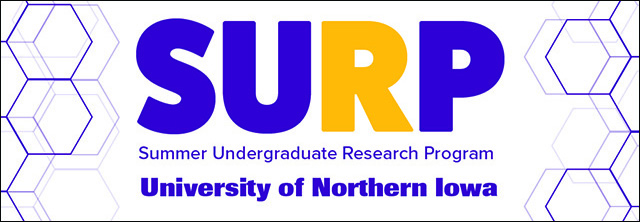
2021 Summer Undergraduate Research Program (SURP) Symposium
Location
Ballroom, Maucker Student Union, University of Northern Iowa
Presentation Type
Open Access Poster Presentation
Document Type
poster
Keywords
Blackboards; Chalk sticks; Erasers;
Abstract
Chalkboard ghosting is a faint image on a chalkboard's surface after writing is erased. Many types of chalk leave a positive image, while the Crayola An-du-septic Anti-dust chalk leaves a negative image. To better understand what cause the ghosting effects, two different types of Crayola chalk (regular and anti-dust) were investigated. Raman spectroscopy and infrared (IR) spectroscopy were used to determine the majority material the chalk was made of, by comparison with pure substances. To identify the organic compound binders holding the chalk sticks together, pulverized chalk was immersed in 40 mL of toluene for at least 30 minutes. After the chalk particles were removed and the toluene evaporated, NMR and LC-MS of the residue (in CDCl3) were taken. Crayola An-du-septic anti-dust chalk is composed of calcium carbonate bound with a mixture of long carbon chain fatty acids. Crayola regular chalk is composed of calcium sulfate dehydrate bound with glycerol-based fatty acid esters. We hypothesize that the differences in the binders is primarily responsible for the different ghosting behavior. The anti-dust fatty acid binder adheres to the surface of the board, and after erasing, the chalk dust does not stick where the fatty acid is, leaving a negative image. The regular chalk fatty acid ester binders adhere to the board and also to the chalk dust, leaving a positive image. It also appears that calcium sulfate is harder to erase than calcium carbonate.
Start Date
30-7-2021 11:30 AM
End Date
30-7-2021 1:15 PM
Event Host
Summer Undergraduate Research Program, University of Northern Iowa
Faculty Advisor
Shoshanna Coon
Faculty Advisor
Kirk Manfredi
Department
Department of Chemistry and Biochemistry
Copyright
©2021 Felicienne Alexandre, Shoshanna Coon, and Kirk Manfredi
File Format
application/pdf
Recommended Citation
Alexandre, Felicienne; Coon, Shoshanna; and Manfredi, Kirk, "Comparison of Chalk Types and Their Ghosting Effects" (2021). Summer Undergraduate Research Program (SURP) Symposium. 17.
https://scholarworks.uni.edu/surp/2021/all/17
Comparison of Chalk Types and Their Ghosting Effects
Ballroom, Maucker Student Union, University of Northern Iowa
Chalkboard ghosting is a faint image on a chalkboard's surface after writing is erased. Many types of chalk leave a positive image, while the Crayola An-du-septic Anti-dust chalk leaves a negative image. To better understand what cause the ghosting effects, two different types of Crayola chalk (regular and anti-dust) were investigated. Raman spectroscopy and infrared (IR) spectroscopy were used to determine the majority material the chalk was made of, by comparison with pure substances. To identify the organic compound binders holding the chalk sticks together, pulverized chalk was immersed in 40 mL of toluene for at least 30 minutes. After the chalk particles were removed and the toluene evaporated, NMR and LC-MS of the residue (in CDCl3) were taken. Crayola An-du-septic anti-dust chalk is composed of calcium carbonate bound with a mixture of long carbon chain fatty acids. Crayola regular chalk is composed of calcium sulfate dehydrate bound with glycerol-based fatty acid esters. We hypothesize that the differences in the binders is primarily responsible for the different ghosting behavior. The anti-dust fatty acid binder adheres to the surface of the board, and after erasing, the chalk dust does not stick where the fatty acid is, leaving a negative image. The regular chalk fatty acid ester binders adhere to the board and also to the chalk dust, leaving a positive image. It also appears that calcium sulfate is harder to erase than calcium carbonate.


